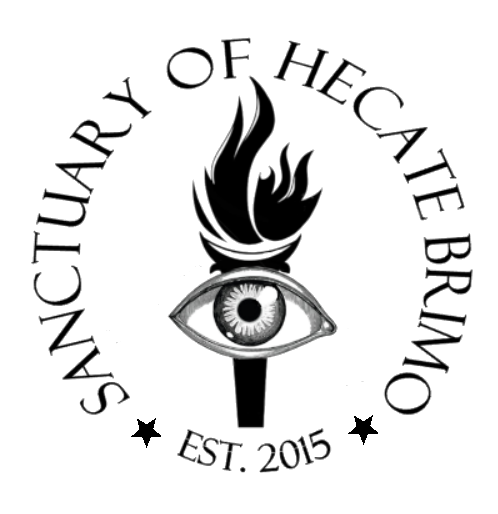Among the most fascinating pieces of evidence for the blending of Greek and Egyptian spiritual traditions are the magical amulets produced in the Roman Imperial period. These engraved stones—sometimes called magical gems or intaglios—carried images of deities alongside strings of mysterious words of power known as voces magicae. Their purpose was both protective and transformative, drawing on the combined powers of gods who crossed cultural and spiritual boundaries.
 |
One particularly striking example shows Hecate and Anubis standing side by side.
On the left, Anubis appears in his jackal-headed form. He wears a short tunic and holds ritual implements, sometimes depicted as a whip, scepter, or circular object. In Egyptian religion, Anubis was the god of embalming, guardian of tombs, and guide of souls into the afterlife. In the context of Greco-Egyptian magic, however, his role expanded: he became not only a psychopomp but also a protector against hostile forces and a powerful ally in magical rites.
On the right stands Hecate, depicted in her multi-armed form, a visual shorthand for overwhelming magical authority. In some versions she holds torches, daggers, and whips, emphasizing her dominion over crossroads, thresholds, and unseen realms. To see Hecate carved with six or more arms is to see her as a goddess whose power radiates in all directions at once.
Beneath the figures runs a line of Greek letters. While they may look like a secret message, these are not meant to be read as ordinary words. They are voces magicae—the “barbarous names” or divine syllables that appear throughout the Greek Magical Papyri (PGM). Spoken aloud in ritual, these strange sequences of sounds were believed to carry the raw power of the divine, bypassing the limits of human language.
The pairing of Hecate with Anubis is not accidental. Both are liminal deities—those who dwell at the thresholds between life and death, light and shadow, the mortal world and the divine.
Hecate: Guardian of crossroads, torch-bearer, key-holder, mistress of magic and necromancy.
Anubis: Protector of tombs, guide of souls, overseer of the weighing of the heart in the halls of Ma’at.
Together, they amplify one another’s authority as chthonic protectors and guides. A practitioner carrying such a gem would be invoking not just protection, but the ability to move safely across boundaries, whether those boundaries were physical, spiritual, or magical.
I have a written work on the paring that you can find here.
These amulets remind us that the ancient world was not neatly divided into “Greek” or “Egyptian” religion. In cities like Alexandria, spiritual traditions blended, evolved, and cross-pollinated. Hecate, once a goddess of the Greek world, and Anubis, deeply rooted in Egyptian tradition, could meet in the magical imagination of practitioners who sought the strongest allies possible in their ritual work.
This is not historical syncretism for its own sake—it is evidence of living devotion, where worshippers and magicians found resonance in the shared roles of deities who guided souls, guarded the in-between, and held the keys to mystery.
For modern practitioners, this amulet offers a reminder that the sacred often resides in the spaces between traditions. Hecate and Anubis both invite us to face thresholds with courage. Where Hecate’s torches illuminate the unseen paths, Anubis’s steady presence ensures that the journey through shadow leads to truth, not fear.
Together, they show us that wisdom and protection are not bound by culture but arise wherever humans seek the divine at the crossroads of life and death.
Devotional
Hecate, torch-bearer,
light the crossroads with your flame.
Keeper of keys, opener of ways,
guide me through shadow into truth.
Anubis, guardian of souls,
jackal-headed protector,
stand beside me at the threshold,
weigh my heart with justice and courage.
Together, walk with me in the liminal,
that I may pass safely,
learn deeply,
and rise transformed.
Have a glorious day!!
Rev. Renee Sosanna Olson
Torchbearer and Keybearer - Covenant of Hekate
Have a glorious day!
BY HER FIRES.COM
Sources & Further Reading
Campbell Bonner, Studies in Magical Amulets (1950).
The Greek Magical Papyri (PGM), translations by Hans Dieter Betz.
The Magical Gems Database (Universität Wien).
Devotional
Hecate, torch-bearer,
light the crossroads with your flame.
Keeper of keys, opener of ways,
guide me through shadow into truth.
Anubis, guardian of souls,
jackal-headed protector,
stand beside me at the threshold,
weigh my heart with justice and courage.
Together, walk with me in the liminal,
that I may pass safely,
learn deeply,
and rise transformed.


























